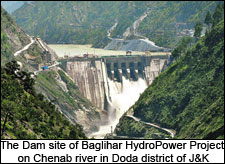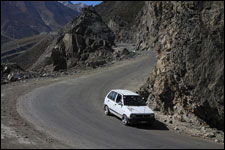 Youngest Union minister at 29 and youngest Chief Minister of Jammu & Kashmir at 39, clearly youth has favoured Omar Abdullah throughout his political career. The charismatic 41-year old scion of Kashmir’s ‘first family’ is heading a National Conference-Congress coalition government in India’s northern most state since January 2009. While tourism continues to remain the mainstay of J&K, Omar has realised the critical importance of developing other sectors such as hydropower and transportation. In an exclusive interview with Jibran Buchh, he talks about his plans to modernise infrastructure in Jammu & Kashmir and integrate its economy with the rest of the country.
Youngest Union minister at 29 and youngest Chief Minister of Jammu & Kashmir at 39, clearly youth has favoured Omar Abdullah throughout his political career. The charismatic 41-year old scion of Kashmir’s ‘first family’ is heading a National Conference-Congress coalition government in India’s northern most state since January 2009. While tourism continues to remain the mainstay of J&K, Omar has realised the critical importance of developing other sectors such as hydropower and transportation. In an exclusive interview with Jibran Buchh, he talks about his plans to modernise infrastructure in Jammu & Kashmir and integrate its economy with the rest of the country.
Let us begin with the power industry. What initiatives has your administration taken to develop hydro potential in Jammu & Kashmir?
Well, knowing as we do that J&K has enormous hydropower potential—which is estimated at around 15,000 to 20,000 mw—we have been only able to realise 2,000 mw from all the projects put together, whether state or central projects. Clearly, there is a wide gap between how much we can exploit and how much we have done so far.
The state government doesn’t have enough resources to exploit this entire potential on its own and so we are now following a three-track approach.
One, there are certain projects with NHPC which will continue to develop and as per agreement the state will get a specific percentage of power free of cost.
Second, we have entered into a joint venture. J&K State Power Development Corporation Ltd, NHPC Ltd and PTC India Ltd are now joint venture partners in a power development company that will develop three large hydroelectric projects and then, subsequently, we will look to expand that.
Third, we will be focusing on state-owned projects like Baglihar-II and Sawalkot hydropower projects. The Ratle hydel project was handed over to GVK Group on tariff-based competitive bidding and the group is now in the process of developing the project.
 You also announced a new hydropower policy.
You also announced a new hydropower policy.
Yes, we recently announced our hydropower policy where power projects from 2 to 100 mw will be developed largely with private sector participation. We will be advertising a large number of projects under this policy and hope that Independent Power Producers will develop those projects and we will buy back the power generated.
Baglihar-I went through a lot of ups and downs with Pakistan contesting several issues, thus, delaying its completion by a few years. Do you foresee similar problems for phase-II?
Not at the moment. In fact, the essential civil work for phase-II has already been done. It’s the same dam which is going to be used; only the tunnelling and the powerhouse need to be excavated.
In the first three quarters of 2010-11, J&K faced a power shortage of 25 per cent- only 7,556 million kWh was generated against a demand of 10,101 million kWh. How do you plan to plug the shortfall?
We need to increase our power generation capacity and that’s what we are doing, not counting NHPC because the power flows outside the state and we have to buy it back. We are focusing on joint ventures and on the state projects and hope to add 2,000 mw in next few years and, most probably, that is what we believe is going to fill the gap in demand and supply.
|
TOP TEN PROJECTS IN JAMMU & KASHMIR
|
||
| Promoter | Project | Cost (` crore) |
| Northern Railway | Udhampur-Srinagar-Baramula BG Line | 11,270.00 |
| Chenab Valley Power Projects | Pakal Dul Hydel | 7,464.05 |
| J&K State Power Development Corporation | Sawalkot Hydel | 7,000.00 |
| J&K State Power Development Corporation | Ratle Hydroelectric Power (Kishtwar) | 5,000.00 |
| NHPC | Bursar Hydel | 4,378.19 |
| Chenab Valley Power Projects Pvt. Ltd | Kawar Hydropower | 4,273.18 |
| NHPC Ltd | Kishenganga Hydel | 3,642.00 |
| National Highways Authority of India | Road Upgradation (Chenani-Nashri) | 2,519.00 |
| J&K State Power Development Corporation | Baglihar Hydel Project [Stage-II] | 2,113.09 |
| National Highways Authority of India | Road Upgradation (Qazigund-Banihal) | 1,987.00 |
| Source: www.projectstoday.com | ||
J&K’s aggregate and technical commercial (AT&C) losses are currently an appalling 50 per cent which points to great disarray in the power distribution sector.
Shortfall in generation on one hand and transmission and distribution losses on the other are the areas of concern. When I am left with a budget of Rs.1,700 crore on account of power that I have purchased but I am not realising revenues for, then that’s something I need to worry about because a state as poor as J&K can’t afford to lose Rs.1,700 crore on the power sector. Now these problems are there because of historical reasons that we have inherited. For example, an antiquated T&D system, absence of metering, rampant theft of power, lack of incentive-based schemes for power tariff realisation, all of which combine to create a situation which we face right now.
On transmission and distribution side, we are looking at outsourcing revenue collection in some parts of Jammu and Srinagar on a pilot project basis. If it works, we will widen it. At the same time we are trying to fast track the implementation of R-APDRP scheme of Government of India which envisages computerisation and automation in order to reduce billing losses and improve collections. So while there is no overnight solution, we hope that the steps we have taken will tackle the problems.
|
||||||||||||||||||||||||||||
How is the human resource situation in J&K power sector? Does JKSPDC have enough technicians, engineers and other skilled workers?
Well, we do have skilled manpower but obviously the number needs to scale up as the responsibilities increase. The shortcoming of human resource was made apparent once when Baglihar was ready and we didn’t have the manpower to run the project. As a result, we had to give a twoyear operation and maintenance contract to NHPC which also included a training component; that period has now expired.
We believe that there is enough manpower present now; but clearly, if JKSPDC scales up its operation we will also have to scale up the human resource pool.
Is the Centre being helpful, for instance, with free flow of funds?
Yes, the central government is being very helpful. But I believe that the Centre is not in a position to guarantee free flow of resources because it has its constraints. But within those constraints the central government is doing its best to help us.
 You recently laid the stone towards the four laning of the Qazigund-Banihal section of NH-44 in J&K. What other infrastructure are we going to witness in coming years?
You recently laid the stone towards the four laning of the Qazigund-Banihal section of NH-44 in J&K. What other infrastructure are we going to witness in coming years?
Connectivity happens to be the biggest concern because we just have one road that connects the Valley with the rest of the country. Five years from now we will have a four-lane highway with extensive use of tunnelling. Apart from this the Mughal Road will be ready and it will provide alternative connectivity between the Valley and the rest of the country.
We are also examining other tunnels in Pir Panjal region, Singhpora-Wailoo (connecting Kishtwar district with Anantnag) and Desa-Kapran in Anantnaag, which will provide all-weather connectivity for Jammu & Kashmir. Basically, when one road gets cut off the whole Valley gets cut off from the rest of the country. That needs to be addressed and that is our major concern.
What about railway projects?
The work on railway projects is going on. Hopefully, the channel between the Valley and Jammu under the Banihal Pass will be through by next year and soon after that we will be able to start rail services up to Banihal. Then what is left is connecting Udhampur and Katra that will be ready by next year and Katra to Banihal which will take another five to seven years to complete.











